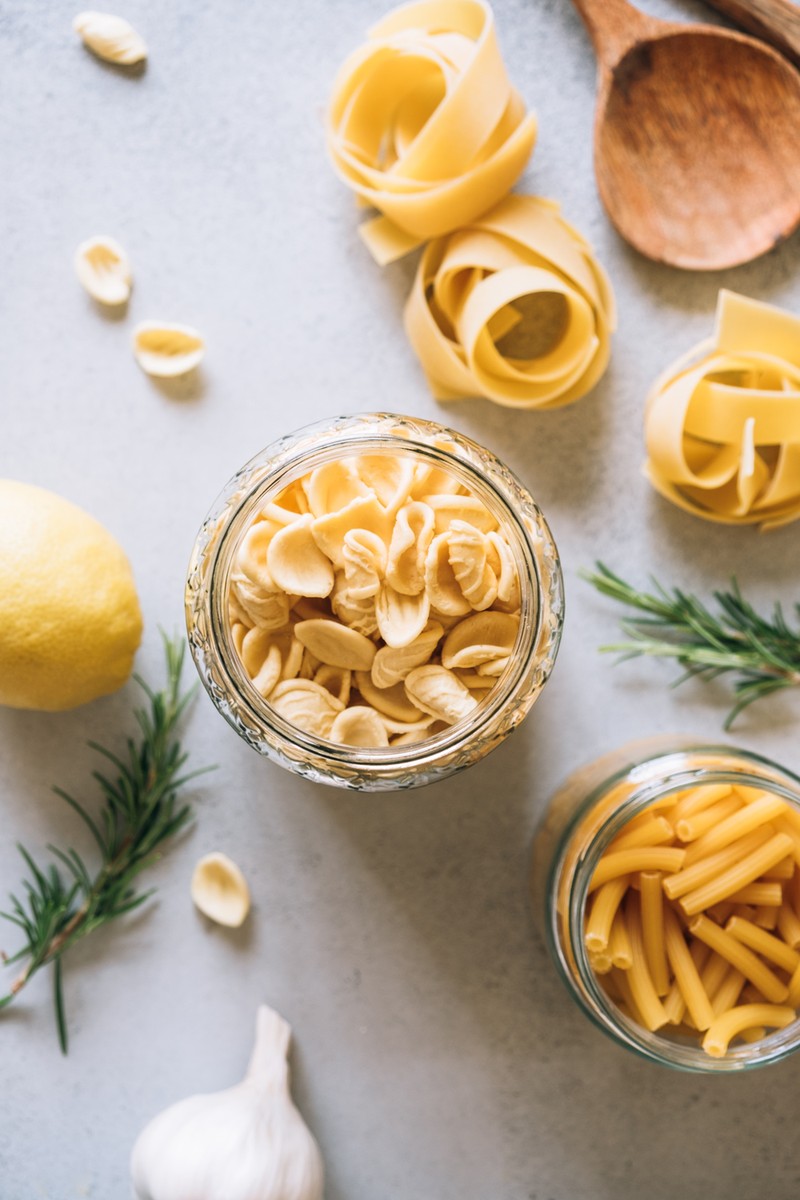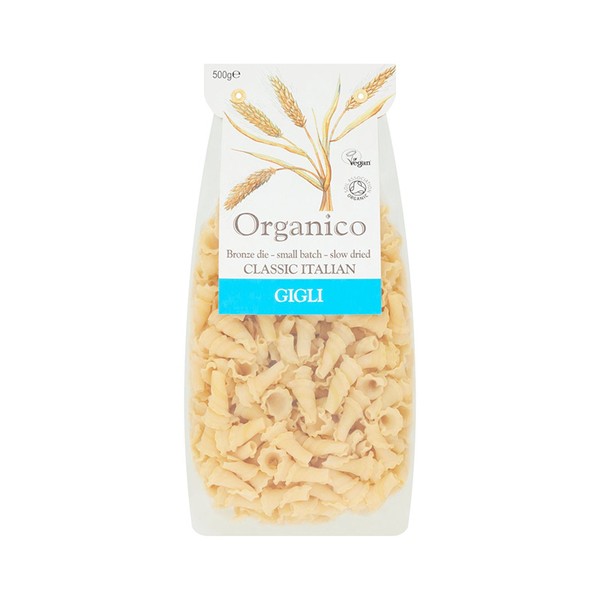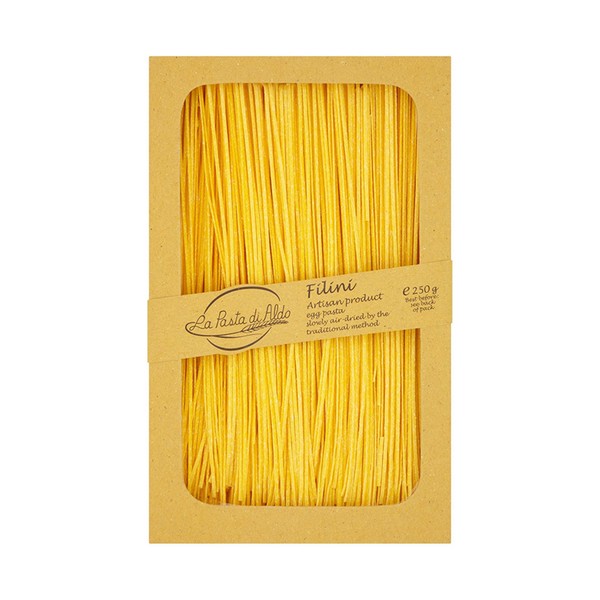Pasta 101 – The Ultimate At-Home Guide

THE MAIN TYPES OF PASTA
There are many types of pasta in Italian cuisine, and each one has an ideal sauce to partner it. According to Guido Pedrelli, founder of Nonna Box, the right pasta can make a good sauce extra special, while the wrong one can ruin the potential of a dish. Here, he provides an insight into the most popular types of pasta – and what to pair them with.
Fusilli & Spirali
These pastas have a curly shape like corkscrews: fusilli is slightly tighter, but other than that it has very similar properties to spirali. Both should be paired with coarse sauces that can flow into the screw threads to make the perfect bite. A flavourful pesto or arrabbiata makes a great pairing as the rich flavour will sit perfectly on the twists. Lighter and smoother sauces can also work with these shapes, but thicker sauces will get locked into the swirls. The chewy texture of the pasta makes it a great addition to any salad. It’s best analyse how narrow or wide the curves of the fusilli are and match the chunky ingredients of the sauce accordingly.
Penne
Penne are tubular shapes cut on an angle. Penne rigate has a ribbed surface, while penne lisce is smooth – you should opt for thicker sauces with lots of ingredients for both as they cling to the pasta. The angled ends help to trap the sauce in the centre, and they pair well with a wide range of sauces from meat to cheese and those which have a vinaigrette base. Penne also is brilliant with bolognese or ragu, as the thicker texture holds the flavour perfectly. As the pasta can be baked in sauce, it makes for a very versatile shape.
Spaghetti
Spaghetti is widely loved and very versatile. It’s best served with a loose and light tomato sauce or even no sauce at all – just cheese and pepper. Wholewheat spaghetti pairs well with chunky sauces due to the earthy flavour and ridged texture. A thinner spaghetti can fall apart if overcooked, so cook with plenty of olive oil or in a broth-based sauce. The traditional bolognese is always a winner with spaghetti, as the rich tomato sauce clings well to the thick strands while being wrapped full of flavour. When it comes to the amount of sauce to use, always be generous to ensure the spaghetti is soaked in the rich sauce. Applying sparingly will leave the dish lacking in flavour.
Farfalle
Farfalle is cut into squares then pinched in the centre to make its distinctive bow-tie shape. The centre tends to be slightly chewy as it can be difficult to get the perfect bite, so it is great when paired with creamy sauces or simply tossed with olive oil. The ‘wings’ hold sauces perfectly, but since they are of a delicate shape, farfalle is better matched with light and fresh sauces, as heavy ones can leave it feeling weighed down. Creamy bases work better than tomato here as the pasta is weightless. Traditionally the pasta is enjoyed in the summer with a light sauce topped off with fresh vegetables.

Tagliatelle
The width of tagliatelle tends to ‘spread’ on the tongue and is best accompanied with a thick hearty meat sauce. If you want even more flavour, it also tastes great with pesto. The long wide ribbons work great with rich and heavy sauces as it picks them up and absorbs the flavour without becoming too gluey. The wide surface works well with creamy sauces as it sticks firmly onto the pasta. This pasta is very versatile and works well with most sauces, just ensure you have cooked it to the perfect bite, so the pasta works together with the sauce as opposed to sitting next to it.
Bucatini
Bucatini is similar to spaghetti, but is larger in size and hollow right through to the centre. This pasta pairs well with thick sauces like beef-shin ragu. The unique factor is that unlike other pastas, it gets coated but also filled with sauce – the hole in the spaghetti encourages sauce to its make way into it. This guarantees heaps of flavour throughout the whole dish.
Rigatoni
Rigatoni has similar properties to penne. They are tubes with ridges on the outside, but unlike penne, they’re bigger and cut square as opposed to at an angle. It matches well with chunky veg and meat sauces thanks to the consistency, shape and ridges. It’s also good with a simple tomato sauce, while the ease in retaining sauce makes it an ideal candidate for baked pasta dishes.
Ravioli
Ravioli is a very traditional dish and is a favourite worldwide. They’re made with small sheets of pasta, folded over a portion of stuffing and pinched together to create a small parcel. The filling can include anything from meat to cheese or veg – a lot of things work well. Ideal sauces can range from lashings of light garlic and butter to heavy tomato-based ragus. The fillings and sauce need to complement each other, as the egg pasta sheet of the parcel will separate once you take a bite.
Pappardelle
Pappardelle are wide ribbons of egg pasta. Due to the large surface area, heavy sauces accompanied with vegetables, such as wild mushrooms, tend to be a favourite. Chunky ingredients in the sauce tend to get trapped between the flat noodles, so you get a hit of flavour on every forkful.
Gnocchi
Gnocchi are little dumplings, usually made from potatoes. In terms of cooking, it’s one of the easiest and quickest pasta shapes to get right. Gnocchi teams up great with rich, creamy sauces such as gorgonzola but is also just as nice with lighter-based sauces such as tomato pomodoro. A simple sauce of butter, fresh sage leaves and parmesan is a traditional favourite for gnocchi.

Inspired To Get Cooking? Here’s Every Variety You Need












HOW TO MAKE YOUR OWN
Rachel Roddy is a Guardian recipe columnist and award-winning food writer who counts Nigella Lawson, Nigel Slater and Angela Hartnett among her fans. In her cookbook An A-Z of Pasta, she condenses everything she’s learned about Italy's favourite food into a practical, easy-to-use collection of more than 120 essential recipes. Here, she explains how to make fresh pasta dough from scratch.
This is the ultimate recipe for a hard wheat flour and water dough, which is suitable for all flour and water pasta recipes, such as pici and orecchiette. The first time you try this, treat it like a game, notice how the coarse semola and water comes together, how dry and scraggy it feels to begin with, then how it softens as you knead. Weather, humidity, the flour, how dry your hands are, all play a part in this; the first step is to notice. Also, identify your work spot, keeping in mind you need a kneading area and space to spread the shapes once you have made them. The proportions are 2:1, so for every 100g of semola, you’ll need 50ml of warm water.
To make pasta for four, you need 400g of semola and 200ml of warm water. Working on wood is best as it creates heat and friction, but you can also work in a bowl, or in a food processor. Working on a board, tip the semola into a wide mountain and add the water bit by bit, pinching it into the flour so it doesn’t run away. Once you have added all the water, bring it into a rough ball, then knead, in the most comfortable way for you (I use the heel of my hand to fold the dough over itself and then push and rotate). Avoid adding extra water until you have kneaded for a while. If still it feels dry or flaky after 2 minutes, a few drops or light spray of water on the board may well be enough.
Knead for at least 6 minutes, or until the dough is smooth and silky – when you hold it against your cheek, it should feel lovely. Rest under an upturned bowl for 30 minutes before shaping according to the recipe.
Feeling hungry? Here are some of our favourite recipes to try at home…

Fresh Capelli D’angelo With Prawns & Lemon
Bring a large pan of water to the boil for the pasta.
In a large frying pan, warm the oil, garlic and chilli gently to infuse the oil. Add the prawns, stir, then raise the heat, add the wine and a pinch of salt and allow to bubble for 3 minutes while you cook the pasta – which will only take a minute or so.
Drain the pasta, or lift directly into the prawn pan, add the lemon zest and parsley, then toss for the last time, and serve.

Sausage Malloreddus
Bash the fennel seeds, chilli and rosemary in a pestle and mortar until ground and nicely combined. Heat a splash of olive oil in a nice heavy casserole style pan and add the garlic. When it begins to colour and becomes sticky, add the fennel mixture, stir for a moment, then squeeze the sausage meat out of the skins and into the pan. Fry until the meat colours breaking it up a little with a spoon as you go.
Stir in the white wine and cook until it reduces. Add the tomatoes, then turn the heat down and cook very gently for a couple of hours.
Bring a pan of salted water to the boil and cook the pasta according to the packet instructions. Drain, keeping back some of the cooking water.
Stir the pasta through the sausage sauce, then add the parmesan and a little cooking water if it needs loosening, sprinkle with parmesan or toasted breadcrumbs.

Gnocchi Alla Sorrentina
First, make the tomato sauce. Add the olive oil to a large heavy-based pan. Heat for 3 minutes and add the fresh tomatoes. Crush a few of the tomatoes with the back of a spoon to release their juice. Using an immersion blender placed directly in the can, purée the canned tomatoes and add to the pan. Season with salt and pepper. Gently simmer for 1 hour, stirring occasionally. For a less runny consistency, continue to cook for a further 1 hour. When cooked, adjust the seasoning if necessary.
Preheat the oven to 180°C. Bring a large pan of salted water to the boil and cook the gnocchi for about 3 minutes: they will rise to the surface when cooked.
Drain and put into a separate large pan with 400g of the tomato sauce. Reheat over a high heat, stirring continuously, for 3 minutes.
Remove from the heat, stir in the parmesan cheese and season with salt and pepper. Transfer everything to a baking dish and arrange the diced mozzarella on top with the remaining parmesan. Bake in the preheated oven for 10 minutes until the cheese has melted and has begun to form a crust.
Remove from the oven, garnish with the basil leaves and serve immediately.

Spaghetti Vongole
Bring a large saucepan of heavily salted water to the boil. Add the spaghetti and cook for a minute or two less than the suggested time on the packet so it's al dente and not quite cooked (you will finish cooking the pasta at the end). Get the clams on while the spaghetti is cooking, and when you drain the pasta be sure to save 2-3 ladles of the cooking water as you will add this to the sauce later.
Put a large, dry saucepan over a high heat and let it get really hot. Throw in the clams with the wine and quickly cover to steam the clams for 1-2 minutes, until they have opened. Strain the clams through a sieve (discarding any that remain closed, just as you do with mussels), reserving the liquor in a bowl underneath. Pick the clam meat out of about 80% of the shells, and save the other 20% to serve.
Meanwhile, heat the oil in a large frying pan or wok over a medium heat, add the sliced garlic and crushed chillies and fry for 2-3 minutes until the garlic starts to pick up a little colour. Next, add the chopped tomatoes and fry for a few minutes until they start to break down into the oil. Now pour in the winey clam stock, being careful not to pour in the last bit at the bottom as this can often be a bit sandy or gritty. Whack the heat right up and allow it to reduce to a soupy sauce, then add the spaghetti, the reserved pasta cooking water (start with 2 ladles and add another if you need to), the picked clams and the clams still in their shells.
Stir through the parsley and lemon juice and allow the whole lot to boil for 1-2 minutes to finish off cooking the pasta and allow it to absorb the sauce. Season with a good pinch of salt and some freshly ground pepper and serve immediately.
DISCLAIMER: We endeavour to always credit the correct original source of every image we use. If you think a credit may be incorrect, please contact us at info@sheerluxe.com.


